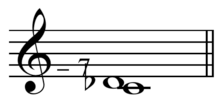Septimal third tone
A septimal 1/3-tone (in music) is an interval with the ratio of 28:27,[1] which is the difference between the perfect fourth and the supermajor third. It is about 62.96 cents wide. The septimal 1/3-tone can be viewed either as a musical interval in its own right, or as a comma; if it is tempered out in a given tuning system, the distinction between these two intervals is lost. The septimal 1/3-tone may be derived from the harmonic series as the interval between the twenty-seventh and twenty-eighth harmonics. It may be considered a diesis.[2]

The septimal 1/3-tone, along with the septimal diesis is tempered out by five-tone equal temperament, and equal temperaments which divide the octave into a small multiple of 5 steps, such as 15-TET and 25-TET. This family of scales is known as Blackwood temperament in honor of Easley Blackwood, Jr., who first analyzed 10-note subsets of 15-TET that take advantage of the temperament.
When added to the 15:14 semitone, the 21:20 semitone and 28:27 semitone produce the 9:8 tone (major tone) and 10:9 tone (minor tone), respectively.
It is the difference between 7/6 and 9/8 (tritē and paramesē).[3][4]
Septimal sixth tone
The septimal sixth tone, also called the jubilisma, is a 7-limit musical interval approximately the size of 1/6 of a whole tone (203.91/6=33.99 cents). An interval with the ratio of 50:49 (![]()
References
- Haluska, Jan (2003). The Mathematical Theory of Tone Systems, p.xxiv. ISBN 0-8247-4714-3. 1/3-tone, Archytas inferior 1/4-tone.
- Thomas Christensen, ed. (2002). The Cambridge History of Western Music Theory, p.186. ISBN 9780521623711.
- Huffman, Carl (2005). Archytas of Tarentum: Pythagorean, Philosopher and Mathematician King, p.420. ISBN 9781139444071.
- Andrew Barker, ed. (2004). Greek Musical Writings: Volume 2, Harmonic and Acoustic Theory, p.51. ISBN 9780521616973.